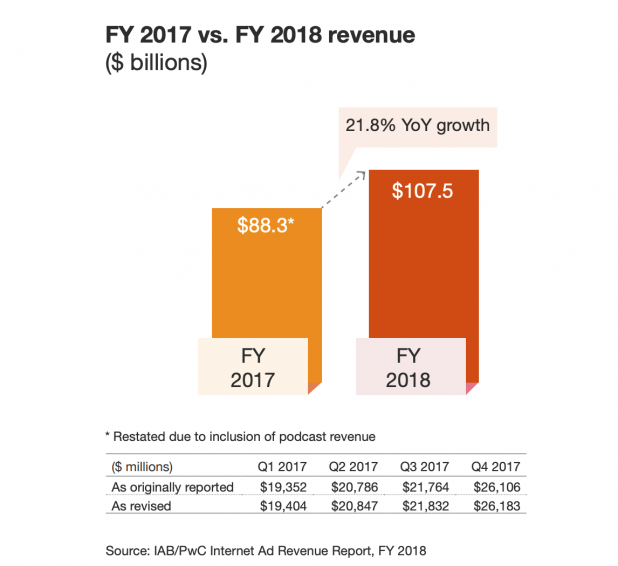Digital advertising continues to achieve robust growth in the U.S. According to the latest report from the Interactive Advertising Bureau (IAB) and PwC, digital advertising generated $107.5 billion in 2018 alone. This figure translates to a 21.8% increase in total ad revenue year over year. However, as many brands continue to dole out significant sums to catch consumer attention, many have begun to question the effectiveness of existing ad metrics.
As the digital advertising ecosystem continues to evolve, many buyers are looking to optimize their return on advertising spend (ROAS). As a result, they have begun exploring more sophisticated ad metrics to capture different levels of consumer attention and engagement. Rather than relying on the minimum standards set by the Media Ratings Council (MRC), these buyers are seeking insightful metrics that accurately reflect consumer attention and engagement. However, before delving into what this means for digital advertising, it’s critical to understand how the programmatic advertising market currently operates.
Digital Advertising Infrastructure
In the digital advertising industry, there are buyers (advertisers), publishers, and intermediaries. Buyers represent brands looking to gain exposure through their paid advertisements via online deployment. Publishers represent online platforms that are paid to display the ads buyers purchase.
Intermediaries have become the most influential component of the digital advertising industry by facilitating the buying and selling of ads. Some of these intermediaries include Doubleclick (Google), AdSense (Google), EPOM, and Facebook. As a result of this extensive intermediary network, most publishers never know the initial price buyers pay for clicks or impressions.

Despite this disconnect, most buyers are known to use a click-per-mille (CPM) purchase model. That is, paying a set amount for every one thousand ad impressions. Although this model has become the industry standard, measuring the quality of these impressions remains elusive. This scenario is precisely why brands are exploring more sophisticated ad metrics. As mentioned, with greater insight, these parties hope to achieve higher levels of consumer engagement and attention.
Digital Advertising Challenges
On their mission to generate a greater return on investment (ROI), brands also face several systemic challenges.
Viewer Privacy
Digital advertising has a tumultuous past when it comes to compromising consumer data. Not only is this data sold unknowingly, but continued data breaches exacerbate consumer concerns.
Low Publisher Revenue
According to the IAB’s Internet Advertising Revenue Report, intermediaries siphoned off approximately 55% of all ad campaign revenue in 2017. The report also states that 75% of online advertising was directed through only ten intermediaries in the same year.
Intrusive Ads
Digital advertising can be obnoxious when it bombards consumers or fails to match their interests. As a result, engagement and attention inherently suffer.
Ad Block
Several web browsers now utilize built-in ad blockers. This functionality undermines the effectiveness of brand advertisements that are never seen by potential consumers.
Fraudulent Impressions
Bots mimic the behavior of real ad viewers. Because most sites pay on a CPM or CPC basis, there is an incentive to generate fake traffic. As a result, site owners run bots to inflate traffic to their website artificially.
Attention-Based Ad Metrics and Blockchain
Despite these challenges, attention-based ad metrics and blockchain technology present promising opportunities. Attention-based advertising metrics break the CPM model down into more precise components. For instance, rather than relying solely on general impressions, buyers and publishers can also assess parameters such as “time-in-view” and “percentage of viewable impressions.”
However, according to a recent report from 33Across Marketing, brands remain highly skeptical of what constitutes a useful attention metric. In exploring potential metrics further, the Financial Times has also put forth an entirely new model known as “cost-per-hour.”

Cost Per Hour (CPH)
When brands execute conventional CPM buyers, all impressions are valued equally. In contrast,
CPH attaches value to each impression based on its deliverable outcome. According to David Buttle, global marketing director for commercial at the Financial Times, “CPH closes the gap between what publishers have traditionally sold – impressions – and what advertisers really want to buy: the attention of their target audience and consequently, marketing outcomes.”
Blockchain-Based Rewards
Some companies have begun rewarding consumers for their engagement and attention by leveraging blockchain technology. These platforms intend to encourage consumer viewership by giving them something in return, usually in the form of cryptocurrency.
The Evolution of Digital Advertising
All indicators suggest that digital advertising will continue to play an essential role in the world of advertising. With robust revenue and an ever-expanding digital marketplace, brands will undoubtedly continue their fight for consumer attention. Although conventional ad metrics were once useful indicators of consumer engagement, new solutions are necessary to ensure optimal ad campaign returns. To validate new metrics, buyers and publishers must work to find common ground. As it stands, 33Across Marketing reports that these parties hold opposing views on metric standardization and implementation.

In the world of digital advertising, a balance must be struck. Publishers understandably want to generate revenue without alienating their audience, and advertisers want platforms that reach the right audience. Through continuous engagement from both sides, solutions such as CPH and blockchain-based rewards hold the potential to transform the world of digital advertising.





